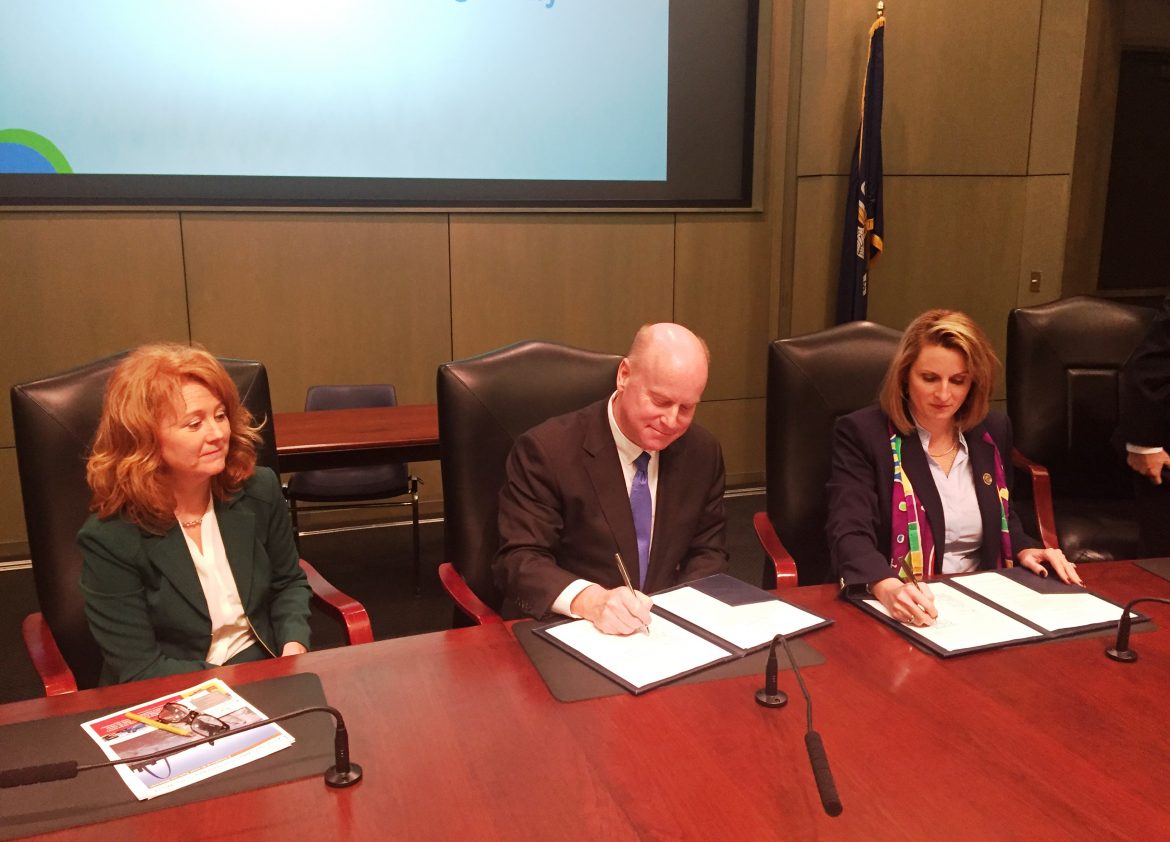
The Board of Commissioners of the Port of New Orleans and the St. Louis Regional Freightway today entered into a Memorandum of Understanding (MOU) to exchange market and operational information with the goal of growing trade and building upon existing and new business relationships between the two regions and critical ports. The agreement also calls for joint marketing efforts to meet those objectives.
The MOU is the culmination of discussions begun during a September 2016 visit to St. Louis by the top official for the Port of New Orleans. At that time, it became evident that it would be mutually beneficial to foster even greater collaboration and leverage the intermodal connectivity between the Port of New Orleans and the St. Louis region.
“The Port of New Orleans historically has strong ties to business and industry via the St. Louis corridor,” said Brandy Christian, President and CEO of the Port of New Orleans. “Located in the Lower Mississippi River system and served by all six Class 1 railroads and the interstate highway system, Port NOLA is the most intermodal port in the nation.
Today’s agreement solidifies our efforts to work with our inland neighbors to develop new opportunities and optimize our connectivity.”
The MOU was signed today by Christian and representatives of the St. Louis Regional Freightway, an enterprise of Bi-State Development (BSD). Signing the agreement were BSD President and Chief Executive Officer John M. Nations, St. Louis Regional Freightway Executive Director Mary C. Lamie; and representatives from each of the three regional ports, Susan Taylor, Director, Port Business Development, St. Louis Development Corporation; Dennis Wilmsmeyer, Executive Director, America’s Central Port; and Ed Weilbacher, General Manager, Kaskaskia Regional Port District. They travelled to New Orleans this week as part of a 11-member delegation from Illinois and Missouri that also included Rick Barbee, Vice President Marketing, SCF Marine; Elizabeth Triggs, Business Development Analyst, Ingram Barge Company; Asim Raza, Chief Legal Officer, Director of Real Estate and Marketing, Terminal Railroad; and consultant Masao Nishi, Principal, M. Nishi Strategic Advisory.
“This agreement, and the collaborative partnership it is founded on, will go a long way toward helping coordinate the Port of New Orleans’ supply chain with our supply chain and enhancing the St. Louis region’s ability to move freight up and down the Mississippi River for the entire nation,” said Lamie. “We now have a framework to work more closely together to generate new business activity that will help accelerate the present level of economic growth by increasing revenues to the Port of New Orleans and optimizing the St. Louis region’s freight network.”
The Port of New Orleans is served by the Mississippi River and its tributaries, which combined offer 14,500 miles of navigable waterways. With three inland ports, including the nation’s third and eighth largest inland ports, the St. Louis region holds an enviable position within that inland waterway system, strategically located in the heart of the nation at the northernmost ice-free and lock-free point on the Mississippi River.
At the core of the MOU is the shared recognition that continued growth at the Port of New Orleans, and future growth around freight movement through the various ports in the bi-state St. Louis region, are intrinsically connected, with 500 million tons of cargo already being handled by the Lower Mississippi River.
Lamie has been working with the team at the Port of New Orleans over the past several months to finalize the details of the MOU, but there was agreement from the outset that branding and jointly marketing the St. Louis region’s multimodal assets, the Port of New Orleans multimodal assets and the St. Louis region’s direct connection to the Port of New Orleans, would be key components. Aside from its significant inland ports, among the other assets the St. Louis region offers are six Class I railroads with international market access (the same six that also operate at Port of New Orleans), two international cargo airports, two foreign trade zones and four interstates that provide national access.
Nations commented on the importance of the MOU for the St. Louis Regional Freightway, which is the newest BSD enterprise. “We believe the agreement entered into this week will stand as one of the most significant accomplishments of The Freightway due to the far-reaching positive impact it will have for the region and the nation,” Nations said. “With a projected 40 percent growth in freight volume over the next 30 years, the actions we take today are laying the groundwork for our region to be a premier gateway for the freight community in the 21st century.”
Among the opportunities the St. Louis Regional Freightway hopes to swiftly capitalize on are new container-on-barge services. The strengthened relationship fostered by the MOU should help to ensure that as growth continues at the Port of New Orleans, it triggers growth on the inland waterways, and specifically in the St. Louis region where it has been demonstrated that the ports can handle containerized freight shipments.
The bi-state area freight group visited the Seacor AMH Terminal located within the Port of Greater Baton Rouge, Louisiana, on February 22 to tour container-on-barge loading and to learn more about Seacor AMH operations which includes terminal services in the St. Louis area. The delegation also met with Mediterranean Shipping Company (MSC) representatives in Metairie, La., to gain insight into its freight movement through the Port of New Orleans. Prior to signing the MOU, the delegation also met with the U.S. Coast Guard to better understand its operations and coordinated efforts with other governmental agencies in New Orleans and Baton Rouge. Following the MOU signing, the delegation toured the Port of New Orleans aboard its Gen. Kelley fireboat.
About Bi-State Development
Bi-State Development (BSD) owns and operates St. Louis Downtown Airport and the Gateway Arch Riverboats, as well as operates the Gateway Arch Revenue Collections Center and Gateway Arch trams. BSD is the operator of the Metro public transportation system for the St. Louis region, which includes the 87 vehicle, 46-mile MetroLink light rail system; a MetroBus vehicle fleet of approximately 400 vehicles operating on 79 MetroBus routes; and Metro Call-A-Ride, a paratransit fleet of 120 vans. BSD also operates the Bi-State Development Research Institute and the St. Louis Regional Freightway, the region’s freight district.
About Port of New Orleans
The Port of New Orleans is a deep-draft multipurpose port at the center of the world’s busiest port system — Louisiana’s Lower Mississippi River. Connected to major inland markets and Canada via 14,500 miles of waterways, six class-1 railroads and the interstate highway system, the Port is the ideal gateway for steel, project cargo, containers, coffee, natural rubber, chemicals, forest products, manufactured goods and cruising. An extensive network of ocean carrier services, along with added-value services like transloading of bulk into containers, make the Port of New Orleans the superior logistics solution for many types of cargo. To stay ahead of market demand, the Port has invested more than $100 million in capital-improvement projects since 2012 and has a Master Plan to expand the Napoleon Avenue Container Terminal to an annual capacity of 1.5 million TEUs.
